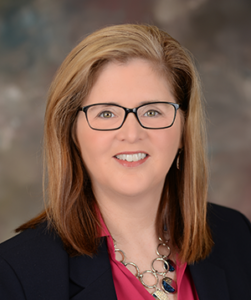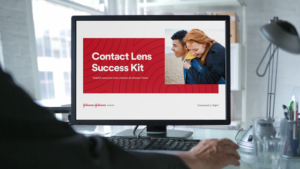

The conventional wisdom says that if it’s a busy day, and an OD already has so much to discuss with a patient – and the patient does not explicitly ask about contact lenses, then they’re probably not all that interested.
But the conventional wisdom seems to be wrong in this case, says Carol L. Alexander, O.D., FAAO, head, North America professional relations at Johnson & Johnson Vision (JJV). “Consumer surveys show that 70 percent of patients who were interested in contact lenses say that it was not discussed during their eye exam,” she says. That’s a lot of patients who might be encouraged to try contact lenses as a full- or part-time vision correction option.
The challenge for eye care professionals is introducing the contact lens conversation into the patient visit easily and conveniently, says Dr. Alexander. So she and her team set out to create a resource to reinforce the message that the doctor is happy to discuss contact lens wear with patients. The result is a new 2021 Contact Lens Success Toolkit from JJV. The resource, a brand-agnostic set of patient-facing and employee-facing resources, is designed to make it easy to introduce the conversation at various points.


PATIENT RESOURCES
Ready-to-use resources include materials that can be used on a practice website, upon check-in, printed and posted in various places in the office or for social media usage. The toolkit includes talking points around these various tools, so that staff members can feel more confident and comfortable about bringing up the contact lens conversation with patients.


For example, a professionally designed factsheet about kids and contact lens readiness is paired with some talking points that could become part of staff training or a discussion point in a staff meeting. These points reinforce that contact lenses are a great option for motivated teens.
- With proper wear and care including good hygiene, contacts can help boost teens’ confidence in school, sports and everyday life.
- Teens surveyed said contact lenses make it easier to see the action when playing sports or other physical activities.1
- Safety, hygiene, comfort and convenience are all important factors when considering contact lenses.
Each of the pages in the toolkit booklet show whether the assets available are for print, digital or social uses.
Practice staff can download assets on an as-needed basis, but these can be used as a foundation for a cohesive contact lens messaging platform over a period of weeks or months. For example, if the doctors and staff make the decision to emphasize contact lens wear for younger patients, then the assets supporting those ideas can be downloaded and used in conjunction with one another.
Social media posts can be circulated on social sites, digital assets can be added to the website and print materials can be posted in the office, creating a complimentary marketing effort.
GET EMPLOYEES TALKING
This toolkit was created with the recognition that new contact lens wearers need support that extends beyond the doctor’s recommendation in the exam room. So four printed pages can be used to post in a staff break room or staff area. These include facts about the high percentage of patients who are interested in contact lenses but don’t take the initiative to ask and the rate of dropouts – and why that matters to the practice.
These create the opportunities for conversation between the staff, too, and can serve to remind staff members that they can play a role in growing the contact lens practice, says Dr. Alexander.
A two-minute video on the website reinforces how the toolkit can be used. The materials are provided at no cost to practices.
Download the toolkit to determine how these resources can help you spark more conversation.
- Contact Lenses in Pediatrics (“CLIP”) Additional Study Data Post-Study “Lifestyle” Child & Parent Surveys, 2007; Teens said contact lenses made it easier to see the action when playing sports, athletics or other physical activities.



